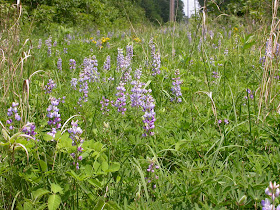
Do you know what this guy did in the last week? He emerged from a chrysalis, drank nectar, and mated (hopefully!), and he will die in the next couple of days. This is the story of the entire one week life span of an adult Karner Blue Butterfly (Plebejus melissa samuelis; Lycaeides melissa samuelis).
The Karner Blue Butterfly is a federally endangered species with a wingspan of only approximately one inch. There are two generations, or broods, per year. Caterpillars of the first brood hatch in April and feed on leaves of wild lupine (Lupinus perennis var. occidentalis), shown below. In early- to mid-May, the caterpillars pupate and spend the next week or two in a chrysalis. Adult butterflies then emerge, mate, and sip nectar from flowers of a variety of plant species. Females then lay eggs on or near wild lupine plants, completing the life cycle of the first brood. The eggs from the first brood hatch about a week later, and caterpillars feed on wild lupine leaves for the next several weeks. These caterpillars then pupate, and adult butterflies of the second brood appear in July. The second brood adults eat, mate, and die; the eggs of the second brood overwinger and hatch the following spring. Because wild lupine is their only host plant, Karner Blue Butterflies are negatively affected as we continue to degrade and destroy habitat for wild lupine.

Wild lupine is not an uncommon plant in the right habitat. Often, it is the dominant groundcover species in black oak savannas and barrens. In the absence of some form of disturbance, however, an open savanna or barren will transition into a woodland and eventually into a forest with too much shade for wild lupine to survive. Fire and macrofauna were historically the main cause of this disturbance, and in some places human-induced fire is still the main mechanism by which savannas escape succession. In our anthropogenic landscape, however, mowing and clearing also serve as disturbances beneficial to wild lupine. In fact, all photographs in this blog post were taken within powerline rights-of-way maintained by mowing/brush-hogging and herbicide application outside of the growing season.

Male and female Karner Blue Butterflies look nearly identical on the ventral side (underside) of the wings. The wings are grayish or grayish-brown with several dark spots with light borders and with a continuous band of blue-green, orange, and black spots along the edges of the hind and forewings. The orange spots distinguish Karner Blue Butterflies from the similar looking Spring Azure (Celastrina ladon), Summer Azure (Celastrina neglecta), and Silvery Blue (Glaucopsyche lygdamus). Eastern-Tailed Blues (Cupido comyntas; Everes comyntas) can also look similar, but have two orange spots and a small tail on the hind wing.

The sex of a Karner Blue Butterfly can best be determined by looking at the dorsal side (upper side) of the wings. The wings of males are an irredescent blue surrounded by a black margin and a white outer band (below).

The dorsal side of female Karner Blue Butterfly wings are dark blue to brown or even charcoal with orange crescents near the outer edges inside the black band; they also have a white outer band (below).
Karner Blue Butterflies are currently known from only eight states: Illinois, Indiana, Michigan, Minnesota, New Hampshire (reintroduced), New York, Ohio (reintroduced), and Wisconsin; they are considered extirpated from Maine, Massachusetts, Pennsylvania, and Ontario, and may have occurred in Iowa but are no longer present there.
I hope you enjoy this short video, which is equivalent to about half of a day in the average human life.
Very cool! The chance to see rare and endangered species is always a highlight.
ReplyDeleteButterflies seem to be uniquely adapted to Lupines. A critically endangered butterfly in the San Francisco region is being reintroduced to a 900 foot hill that's protected habitat in the center of San Francisco, and it feeds on...Lupine!
ReplyDeletehttp://articles.sfgate.com/2010-05-07/bay-area/20887998_1_blue-butterfly-mission-blue-san-francisco-recreation
It took the local native plant folks a few years to get the native lupine reintroduced to the hill before they could reintroduce the butterfly.
Hi Scott and Lindsey .. I love what I read here .. it's so informative with lovely pictures ..
ReplyDeleteThanks .. I love nature .. enjoy Memorial Day - Hilary
Thanks Ted. I agree. There were a few locations where they didn't seem at all like an endangered species, as there were several flying around us at all times.
ReplyDeleteInteresting, Eric. The Mission Blue Butterfly looks a lot like the Karner Blue Butterfly and some of its look-a-likes here. I wonder what it is about lupines that attracts these small blue butterflies.
ReplyDeleteThanks Hilary. I'm glad you enjoy reading and looking at our posts. Keep coming back!
ReplyDelete